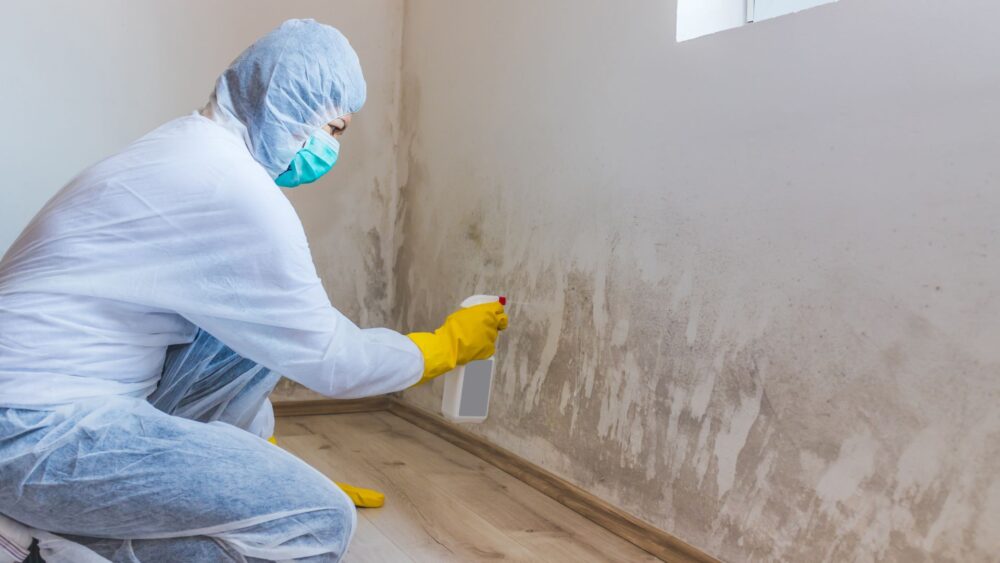Have you ever walked into a room, taken a deep breath, and caught that musty scent that screams ‘mold’? It’s not just unpleasant; it’s a call to arms. When it comes to kicking this unwelcome guest to the curb, knowing your stuff is our biggest superpower. With an average ROI of tackling moisture issues at 3800%, according to studies, ignoring mold prevention isn’t just risky—it can be costly. But fear not! Today we’re breaking down how you can fortify your fortress with easy yet powerful steps towards mold-free living.
Mold Prevention Tips for Your Home
Mold is everywhere. It’s a natural part of our environment, but when it starts growing in your home, it can become a real problem. Mold loves damp, dark spaces and feeds on organic materials like wood, paper, and fabric. If you’re not careful, mold can quickly take over your living space and cause some serious health issues.
But don’t worry, there are plenty of ways to prevent mold growth in your home. The key is to control moisture levels and keep things clean and dry. Here are some tips to get you started:
Identify Problem Areas
The first step in preventing mold is to identify potential problem areas in your home. These are places where moisture tends to collect, like bathrooms, kitchens, basements, and attics. Take a look around and make note of any damp or musty smells, water stains, or visible mold growth.
According to the EPA, mold spores are everywhere, including your home, and they can grow on any surface that has sufficient moisture. So it’s important to keep an eye out for any signs of excess moisture or water damage.
Control Humidity
One of the most effective ways to prevent mold growth is to control the humidity levels in your home. Mold thrives in humid environments, so it’s important to keep indoor humidity below 60% relative humidity, ideally between 30% and 50%.
You can use a dehumidifier to remove excess moisture from the air, especially in damp areas like basements or crawl spaces. Running a fan or opening windows can also help improve air circulation and reduce humidity levels.
Proper Ventilation
Proper ventilation is key to preventing mold growth in your home. Make sure to use exhaust fans in bathrooms and kitchens to remove excess moisture from the air. If you don’t have exhaust fans, crack a window open during showers or while cooking to let the steam escape.
In addition to using fans, it’s important to make sure your home has adequate ventilation overall. This means ensuring that air can flow freely through your living space, especially in areas prone to moisture buildup like attics and crawl spaces.
Dry Wet Areas Immediately
If you do experience a water leak or flood in your home, it’s crucial to dry out the affected areas as quickly as possible. Mold can start growing within 24-48 hours of exposure to moisture, so time is of the essence.
Use fans and dehumidifiers to remove excess moisture from the air and dry out wet materials like carpeting, drywall, and insulation. If the damage is extensive, you may need to call in a professional restoration company to handle the cleanup and repairs.
Use Mold-Resistant Products
When renovating or building a new home, consider using mold-resistant products like moisture-resistant drywall, mold-resistant drywall, and mold inhibitors for paints. These materials are designed to prevent mold growth and can be especially useful in damp areas like bathrooms and basements.
According to Treehugger, one of the best ways to prevent mold is to use mold resistant products during home renovations. For example, you can now buy mold resistant plasterboard and insulation, and paints are available with mold inhibitors.
Common Places Where Mold Grows in Homes
Mold is sneaky. It can grow just about anywhere in your home where there’s moisture and a food source. And once it takes hold, it can spread quickly and cause some serious damage. So where should you be on the lookout for mold growth? Here are some of the most common places mold likes to hide:
Bathrooms
Bathrooms are prime real estate for mold growth. Between the steam from hot showers, leaky faucets, and damp towels, there’s plenty of moisture to go around. Mold loves to grow on shower curtains, grout lines, and even on the ceiling if there’s not enough ventilation.
According to the CDC, mold can start growing in as little as 24-48 hours if the humidity level rises above 60-65%. So if you notice any musty smells or visible mold growth in your bathroom, it’s time to take action.
Kitchens
Kitchens are another common spot for mold growth, especially around the sink and dishwasher. Leaky pipes, damp sponges, and even steam from cooking can all contribute to excess moisture in the air.
Mold can also grow on food that’s been left out too long or stored improperly. So be sure to keep your kitchen clean and dry, and toss any expired or moldy food in the trash.
Basements
Basements are notorious for being damp and musty, which makes them a prime spot for mold growth. Water can seep in through cracks in the foundation or from leaky pipes, creating the perfect environment for mold to thrive.
If you’ve ever experienced a basement flood, you know how quickly mold can take over. According to the EPA, mold can start growing within 24-48 hours of a flood, so it’s important to dry out the area as quickly as possible to prevent further damage.
Attics
Attics are another common spot for mold growth, especially if there’s a leak in the roof or poor ventilation. Mold can grow on wood, insulation, and even on stored items like clothing or furniture.
To prevent mold growth in your attic, make sure there are no leaks in the roof and that the space is properly ventilated. You may also want to consider using mold-resistant insulation or storing items in airtight containers to keep moisture out.
Crawl Spaces
Crawl spaces are often overlooked when it comes to mold prevention, but they can be a major source of moisture and mold growth in your home. Water can seep in through the soil or from leaky pipes, creating a damp environment that’s perfect for mold to thrive.
To prevent mold growth in your crawl space, make sure the area is properly sealed and ventilated. You may also want to consider installing a vapor barrier to keep moisture out and using a dehumidifier to control humidity levels.
How to Get Rid of Mold and Prevent Its Return
So you’ve found mold growing in your home. Now what? Don’t panic. While mold can be a serious problem, there are steps you can take to get rid of it and prevent it from coming back. Here’s what you need to know:
Safety Precautions
Before you start tackling mold growth in your home, it’s important to take some safety precautions. Mold can cause respiratory issues and other health problems, so it’s crucial to protect yourself while cleaning.
According to Martha Stewart, small areas of mold can often be handled by homeowners with a solution of water and detergent. However, it’s crucial not to disturb large areas of mold to avoid spreading spores throughout your home. Always wear protective gear, like gloves and masks, when dealing with mold.
Cleaning Solutions
There are a variety of cleaning solutions you can use to get rid of mold, depending on the surface and severity of the growth. For small areas of mold, a mixture of water and detergent or a natural solution like vinegar can often do the trick.
For tougher mold growth, you may need to use a stronger cleaning solution like bleach or hydrogen peroxide. Just be sure to follow the manufacturer’s instructions and never mix cleaning products together, as this can create toxic fumes.
Drying Techniques
Once you’ve cleaned the moldy area, it’s important to dry it out completely to prevent future growth. Use fans and dehumidifiers to remove excess moisture from the air and open windows to improve ventilation.
If the affected area is large or the damage is extensive, you may need to call in a professional restoration company to handle the drying process. They have specialized equipment and expertise to ensure that the area is completely dry and free of mold spores.
Preventing Future Growth
The best way to deal with mold is to prevent it from growing in the first place. Once you’ve cleaned and dried the affected area, take steps to prevent future moisture buildup and mold growth.
This may include fixing leaks, improving ventilation, using mold-resistant products, and controlling humidity levels in your home. You can also use mold inhibitors in paints and cleaning products to help prevent future growth.
According to the EPA, the key to mold control is moisture control. By solving moisture problems before they become mold problems, you can keep your home healthy and mold-free.
Improving Air Circulation to Reduce Mold Risk
One of the best ways to prevent mold growth in your home is to improve air circulation. Mold loves stagnant, humid air, so by keeping the air moving and reducing moisture levels, you can make your home a lot less inviting to mold spores. Here are some tips for improving air circulation in your home:
Use Fans
Fans are a simple and effective way to improve air circulation in your home. Whether you use ceiling fans, portable fans, or exhaust fans in the bathroom and kitchen, the goal is to keep the air moving and prevent moisture from building up.
According to the EPA, using exhaust fans that vent outside your home in the kitchen and bathroom can help remove excess moisture and improve air circulation. Just be sure to run the fans during and after cooking or showering to ensure that the moisture is properly removed.
Open Windows
Opening windows is another easy way to improve air circulation in your home. By letting fresh air in and stale air out, you can reduce humidity levels and prevent mold growth.
Of course, opening windows isn’t always practical, especially in the middle of winter or during allergy season. But whenever possible, try to let some fresh air into your home to keep things dry and mold-free.
Dehumidifiers
If you live in a particularly humid area or have trouble with excess moisture in your home, a dehumidifier can be a great investment. Dehumidifiers work by removing moisture from the air, which can help prevent mold growth and improve overall air quality.
According to the EPA, keeping indoor humidity below 60% relative humidity, ideally between 30% and 50%, can help prevent mold growth. A dehumidifier can help you maintain these levels, especially in damp areas like basements or crawl spaces.
HVAC Maintenance
Your home’s heating, ventilation, and air conditioning (HVAC) system plays a big role in air circulation and moisture control. Regular maintenance of your HVAC system can help ensure that it’s running efficiently and effectively, which can help prevent mold growth.
This may include changing air filters regularly, cleaning ducts and vents, and ensuring that the system is properly sized for your home. If you’re not sure how to maintain your HVAC system, consider hiring a professional to do an annual checkup and cleaning.
Keeping Your Home Dry to Discourage Mold
Moisture is the enemy when it comes to preventing mold growth in your home. Mold spores need water to grow and thrive, so by keeping your home dry and free of excess moisture, you can make it a lot less inviting to mold. Here are some tips for keeping your home dry and discouraging mold growth:
Fix Leaks Promptly
Leaks are one of the most common sources of excess moisture in homes, and they can quickly lead to mold growth if left unchecked. Whether it’s a leaky faucet, a dripping pipe, or a hole in your roof, it’s important to fix any leaks as soon as you notice them.
According to the EPA, fixing leaks and other water problems immediately is one of the most important steps you can take to prevent mold growth in your home. So don’t put off those repairs – the longer you wait, the more likely it is that mold will start to grow.
Proper Drainage
Proper drainage around your home is essential for preventing water from seeping into your foundation and causing mold growth. Make sure that your gutters and downspouts are clear of debris and that they direct water away from your home’s foundation.
You may also want to consider installing a French drain or other drainage system to help keep water away from your home. By ensuring that water has a clear path away from your foundation, you can reduce the risk of mold growth in your basement or crawl space.
Avoid Drying Clothes Indoors
Drying clothes indoors may be convenient, but it can also contribute to excess moisture in your home. As the clothes dry, they release moisture into the air, which can lead to increased humidity levels and mold growth.
Whenever possible, try to dry your clothes outdoors or in a well-ventilated area. If you must dry clothes indoors, use a dehumidifier to remove excess moisture from the air and keep humidity levels in check.
Wipe Up Spills
Spills happen, but it’s important to clean them up quickly to prevent water damage and mold growth. Whether it’s a spilled glass of water or a leaky pipe, use a towel or mop to soak up the excess moisture as soon as possible.
If the spill is on a porous surface like carpet or drywall, you may need to use a wet/dry vacuum to remove as much water as possible. Once you’ve cleaned up the spill, be sure to dry the area thoroughly to prevent mold from taking hold.
By following these tips and staying vigilant about moisture control, you can keep your home dry and free of mold. Remember, prevention is key when it comes to mold growth – the more proactive you are about keeping your home dry, the less likely it is that you’ll have to deal with a mold problem down the line.
FAQs in Relation to Mold Prevention
What kills and keeps mold away?
Vinegar, bleach, or hydrogen peroxide sprayed directly on mold can kill it quickly. Keeping areas dry is essential to prevent its return.
How can you protect yourself from mold?
When dealing with mold, it’s important to wear gloves, goggles, and a mask. This will protect your skin, eyes, and lungs from spores.
What can I put in my safe to prevent mold?
Placing silica gel packs or a small dehumidifier inside your safe can help absorb moisture, keeping your valuables dry and free from mold.
What is the best mold repellent?
Applying mold-resistant paint to walls can act as a strong barrier against spore invasion. This is particularly useful in damp rooms.
Conclusion
Mold prevention might sound like something out of a high-maintenance homeowner’s manual, but as we’ve seen, it boils down to being mindful about moisture levels in our homes. From fixing leaks promptly to using exhaust fans religiously – these aren’t Herculean tasks; they’re small habits that add up over time. The truth? Living in harmony without the threat of sneaky spores taking over is entirely possible—no evil robots or Hollywood drama needed here! As you continue on your journey toward creating safer indoor spaces remember: each step taken is one less opportunity for molds’ quiet takeover.
So here’s my final word – embrace these tips with open arms because when it comes right down to it, preventing mold doesn’t require fancy gadgets or complicated routines…just some good old-fashioned vigilance and action.




